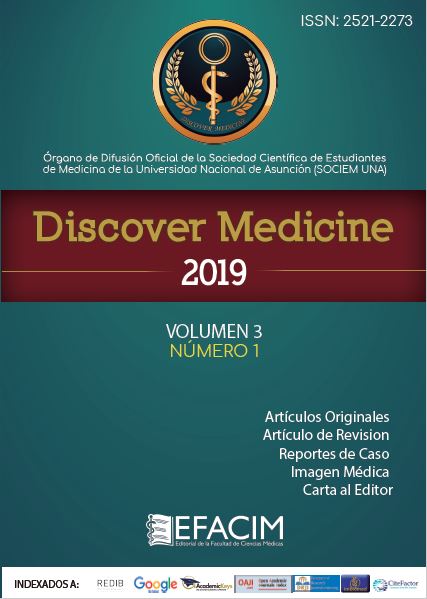Abstract
Fever of unknown origin (FUO) represents a challenge for doctors despite new technologies and tools for diagnosing. It can be divided into four groups: classic, associated to health services, associated to AIDS, and FUO in patients with a compromised inmune system. Classic FUO is defined as: fever >38.3°C (101°F) in at least two instances; a disease that lasts ≥3 weeks; without any known compromised inmune system; and a diagnose that remains unknown after a meticulous medical history, physical exploration and complementary studies. The diseases that cause FUO can be classified in infectious, malignant, noninfectuous inflamatory diseases (NIID), miscelaneous and non diagnosed; NIID are common causes in developed countries, and infectious diseases prevail in undeveloped countries. Clinical tracks are elements that guide us to possible etiologies and to which tests must be accomplished. Some of the tests that can be carried out are: laboratory tests (blood test, liver function tests, serologies, bacteria cultures, autoantibodies), imaging techniques (ultrasounds, x ray, cat scan), nuclear medicine (positron emission tomography), and invasive studies (bone narrow and liver biopsy). At last, the diagnosis will depend of the combination of clinical elements with several test results.
References
Walter E, Hanna-Jumma S, Carraretto M, Forni L. The pathophysiological basis and consequences of fever. Crit Care. 2016; 20(1):200. Disponible en https://www.ncbi.nlm.nih.gov/pmc/articles/PMC4944485/?report=reader
Mackowiak P, Durack D. Mandell, Douglas, and Bennett’s principles and practice of infectious diseases. Vol. 1. Edición 7,. EEUU: Elservier; 2010. capítulo 51, p779-788
Dinarello A, Reuven P. Alteraciones en la temperatura corporal: fiebre. Harrison Principios de Medicina Interna. Vol. 2 Edición 19, México: McGraw‐Hill; 2016. capítulo 26, p 123-126
Álpizar L, Medina E. Fisiopatología de la Fiebre. Rev Cubana Med Milit 1999;28(1):49-54 Disponible en:
http://scielo.sld.cu/scielo.php?script=sci_arttext&pid=S0138-65571999000100008&lng=es.
Unger M, Karanikas G, Kerschbaumer A, Winkler S. Fever of unknown origin (FUO) Wiener klinische Wochenschrift. 2016;(128): 796–801. .Disponible en: https://www.deepdyve.com/lp/springer-journals/fever-of-unknown-origin-fuo-revised-MxOjzlM90k.
Elizabeth C, Robert C. Prolonged Febrile Illness and Fever of Unknown Origin in Adults. Am Fam Physician. 2014; 90(2):91-96. Disponible en: https://www.aafp.org/afp/2014/0715/p91.html.
Mulders C, Simon A, Rovers C. Fever of unknown origin. Clinical Medicine. 2015; 15 (3): 280–284. Disponible en: https://www.researchgate.net/profile/Catharina_Mulders-Manders/publication/277601323_Fever_of_unknown_origin/links/55d4492408ae0a34172282cf/Fever-of-unknown-origin.pdf.
Hernández J, Diaztagle U, Cañón B, Galvis D, Galván L, León N. Fiebre de origen desconocido: un reto clínico hospitales de san josé e infantil universitario de san josé. Repert.med. cir. 2014; 23(1): 56-62. Disponible en: https://www.fucsalud.edu.co/sites/default/files/201701/FIEBRE%20DE%20ORIGEN%20DESCONOCIDO.pdf.
Roca V, Senra L, Rodríguez Hé, Jiménez R, Cepero B. Fiebre de origen desconocido en pacientes mayores de 60 años: Reporte de 40 casos. Rev cubana med [Internet]. 2009 ; 48( 1 ): 11-14. Disponible en: http://scielo.sld.cu/scielo.php?script=sci_arttext&pid=S0034-75232009000100004&lng=es.
Vidal A, Noda A, Bouza Denis I, Delgado M, Sánchez Ca, Montell O, et al . Fiebre de origen desconocido, una forma de presentarse la tuberculosis. Revista Cubana de Pediatría. 2012; 4(2):426-432 . Disponible en: http://scielo.sld.cu/scielo.php?script=sci_arttext&pid=S0034-75312012000400013&lng=es.
Guzmán R, Mejía M, Cadavid V, Barrera M. Síndrome febril prolongado de origen reumatológico. Reporte de tres casos. Revista Cuarzo 2018: 24 (1) 46-49. Disponible en: https://revistas.juanncorpas.edu.co/index.php/cuarzo/article/view/323/336.
Jiménez B, Domínguez B. Enfermedad de Still de inicio en el adulto como causa de fiebre de origen desconocido. Med Int Méx. 2016 ene;32(1):118-128. Disponible en: http://www.medigraphic.com/pdfs/medintmex/mim2016/mim161o.pdf.
Yong Z, Xin C, Xin L, Zhi-qiang Z, Hong-ju X, Gang L. Clinical analysis of 215 consecutive cases with fever of unknown origin A cohort study. Medicine. 2018 Jun; 97(24): e10986. Disponible en https://www.ncbi.nlm.nih.gov/pmc/articles/PMC6024658/pdf/medi-97-e10986.pdf.
Mulders C, Engwerda C, Simon A, Van der Meer J, Bleeker C. Long-term prognosis, treatment, and outcome of patients with fever of unknown origin in whom no diagnosis was made despite extensive investigation: A questionnaire based study. Medicine. 2018; 97(25):e11241. Disponible en https://www.ncbi.nlm.nih.gov/pmc/articles/PMC6024966/.
X. Klejin E, Vandenbroucke J, Van Der Meer J, and The Netherlands FUO Study Group. Fever of Unknown Origin (FUO) I. A prospective multicenter study of 167 patients with FUO, using fixed epidemiologic entry criteria,Medicine.1997;76th ed.(6):392-400. Disponible en: https://repository.ubn.ru.nl/bitstream/handle/2066/15133/5018.pdf?sequence=1
Attard L, Tadolini M, De Rose D, Cattalini M. Overview of fever of unknown origin in adult and paediatric patients, Clin Exp Rheumatol. 2018; 36 Suppl 110(1):10-24. Disponible en: https://www.clinexprheumatol.org/article.asp?a=12467
Takeda R, Mizooka M, Kobayashi T, et al. Key diagnostic features of fever of unknown origin: Medical history and physical findings. J Gen Fam Med. 2017; 18 (3) : 131-134. Disponible en: https://onlinelibrary.wiley.com/journal/21897948
Palafox G, Martin del Campo J. Fiebre de origen desconocido. El reto de la Medicina Interna. Med Int Mex 2011; 27(6):573-585 .Disponible en: http://www.medigraphic.com/pdfs/medintmex/mim-2011/mim116i.pdf.
Romo Jesús, Muñoz Julián. Protocolo diagnóstico en fiebre de origen desconocido para países en vías de desarrollo. An. Fac. med. [Internet]. 2004; 65(2): 127-132. Disponible en: http://www.scielo.org.pe/scielo.php?script=sci_arttext&pid=S1025-55832004000200007&lng=es.
Albín R, Pérez W, Morales F, Cabrera J, Quesada A, Rivero L. Fiebre de origen desconocido. Estudio de 52 casos.
Medisur . 2015 ; 13( 3 ): 391-405. Disponible en: http://scielo.sld.cu/scielo.php?script=sci_arttext&pid=S1727-897X2015000300009&lng=es.
Kouijzer I, Mulders-Manders C, Bleeker-Rovers C, Oyen W. Fever of Unknown Origin: the Value of FDG-PET/CT, Semin Nucl Med. 2018; 48(2):100-107.. Disponible en: https://www.sciencedirect.com/science/article/pii/S0001299817301101

This work is licensed under a Creative Commons Attribution-NonCommercial-NoDerivatives 4.0 International License.
Copyright (c) 2023 Ramón Yefrin Maradiaga Montoya, Andrea María Sierra Barahona, Isabel Ramos Acevedo, Marco Vinicio Molina Cruz
